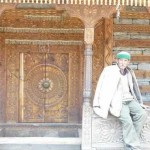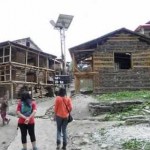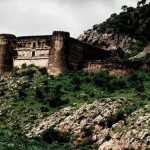1) Touch-me-not: Malana, Himachal Pradesh
Once upon a time there was a Greek chappie called Alexander and since no one played cricket in his country, he was bored and decided to conquer the world. So in 334 BC, he launched an attack on Asia Minor and eight years later, seeking to reach the end of the world, he crossed the Himalayas and entered India. A year later, he withdrew, but some of this soldiers decided to stayed back near Parvati river, in a small village called Malana, in Himachal Pradesh
We do not know if the last part is true, but the village called Malana stand by this steadfastly. They insist that they are pure blood descendants of Alexander’s Greek army, to the extent that they refuse to have any physical contact with anybody outside of their village. They follow their own law, not that of as dictated by the Indian Constitution, and are believed to be the oldest democracy in the world.
When tourists enter the village, there are sign boards all over as to where we can walk, and what we can touch. Touch a Malana house, and you’ll be fined. Even if you want to buy a packet of biscuits at the local shop, leave the money on the counter and collect the biscuits from the table. In an added twist to the tale, Himachal is a flourishing drug trade, you see more cannabis plants on the roadside than apple trees. Maybe Malana and the air of forbiddance it bores, is all part of a bigger plan.
To reach Malana: The nearest major hubs are Manali and Kullu. You can take a bus or cab to Malana from these. Spend a day or two in Malana, and from there you can also proceed to Kasol – a town of Israeli cafes, dreadlocked sadhus and gushing streams.
2) Jurrasic Park desi tadka maarke: Balasinor, Gujarat
Heard of Balasinor? This relatively unknown destination lies just 86 kilometres from Ahmedabad. In 1981, paleontologists discovered some dinosaur fossils here, and over the years have uncovered fossils of over 10,000 dinosaur eggs, making Balasinor the third largest dinosaur hatchery in the world. It is also the only site in the world where tourists are actually allowed to touch the fossils. Imagine holding something that is 65 million years old!
In a shocking twist, the state government has paid little regard to this place, and till some years back cattle were found to be merrily grazing away at the site, stepping on the fossils and even destroying them, albeit unintentionally. Now, thanks to the efforts of Balasinor’s former princess – Aaliya Sultana Babi – there is at least fencing around the site. Aaliya, herself, is an excellent guide and an expert on these fossil remains and conducts regular ‘Dinosaur Park tours’ for travelers.
What is incredible is how little the state government cares about it. With each remnant containing information about the specie’s behavior, eating habits, causes for extinction, these remains become invaluable and need to be protected and preserved. With just two guards to man the place, the chances of these fossils being stolen and sold are that much higher. In 2006, the government initiated work for a dinosaur museum near the site, but it’s still not completed.
Visit the place when you can, or let us know and we’ll arrange a camping trip for you. In this trip, you can also visit Champaner (remember Lagaan?), a UNESCO World Heritage Site, and that lies just 50 kms away.
3) The Lost City: Dhanushkodi
On a December night forty eight years ago a train left Pamban station and at 11:55 pm, minutes before it was to enter Dhanushkodi station, the signal went off. The driver plowed ahead, and within seconds a huge tidal wave struck the train and swept it into sea, killing all 115 people aboard.
Once upon a time, Dhanushkodi was a flourishing town. Across the sea, just 30 kilometres away lies Sri Lanka, and there were daily ferries between the two countries. The cyclone of 1964 changed all that, killing 1800 people in its wake, and submerging the town almost entirely. In a religious twist to the tale, eyewitnesses say that the waves stopped just short of Rameshwaram temple, where thousands of people had taken refuge.
Soon after the disaster, the government declared Dhanushkodi as a ‘ghost town’ and declared it unfit for living. Today, only a few fishermen can be seen on its beaches. Dhanushkodi’s most important attraction is the mysterious Adam’s Bridge, made entirely of out limestone and holding religious significance as it is the bridge that Rama was supposed to have built for crossing over to Lanka.
There are daily jeep tours from Rameswaram, and you can still see the remains of the railways station, hospital, post office and some houses. If you want to visit, the nearest airport is Madurai (167 kms), and the nearest railway station is Rameswaram (18 kms).
4) India’s Most Haunted: Bhangarh
Rajasthan smells of heritage. Everywhere you go, you see men in red turbans and long mustaches, and women in colourful cholis. Forts spring up in every nook and corner, and almost every other hotel is a heritage property. Thousands of foreigners visit Jaipur, Udaipur and Jaisalmer every year, simply for the rich culture and tradition these places exude.
And just around the corner, lies a town that is only spoken of in hushed whispers. They say that the land is cursed and that no civilization has been able to settle itself within the boundaries. People who have been there have reported to have felt a queasy and unnerving feeling. An ASI board says that “no one is allowed to stay in this fort town after sunset till sunrise. It is also the only historical site in the country which does not have an ASI office. Every night, the guards close the fort gates and then lock themselves up in a small room inside the fort, and just outside sits a Hanuman idol.
A number of stories abound in the internet, about youths who hid near the gates and then climbed over the walls of the town to figure out for themselves if the town is really infested with ghosts. As the stories suggest, some went mad, some were attacked, while some saw just lone figures in the distance, harmless yet spooky.
It is difficult to say if there really is any paranormal activity prevalent in Bhangarh, if it’s just a fiction of human imagination under stress, or a smart marketing plan. But then why don’t you find out for yourself?
5) Skeleton Lake : Roopkund
It was the year of 1942, and a Nanda Devi Game Reserve ranger was doing his usual walks when he spotted almost 500 skeletons at the edge of Roopkund Lake. Initially, it was hypothesized that the people might have died of an epidemic or a landslide, but later in the 60s when carbon dating was done on the bodies, it was found that they belonged to the 12th – 15th century. In 2004, another panel of experts visited the site and gathered valuable information. Fractures on the skulls indicate that the people had died during a hailstorm. The hailstones has been as large as cricket balls, and with no shelter, all the people had perished. Remarkably, the scientists also found several bodies with the flesh intact and the body fully preserved in these icy environs.
The route to Roopkund is beautiful, large grasslands, streams and villages making up the landscape. What was once a elatively unknown place shot into prominence that day in 1942, and today the Roopkund circuit is now one of India’s most famous treks.
-
Well, that’s all for today folks. Would be great if you could let us know of other unusual places that you know of, or have been to! Or if you have been to Bhangarh, maybe you can tell us of your experiences there, for we aren’t sure we believe in haunted tales ![]()
Oh and if you want to see more places, here’s our collection of 100 best offbeat holidays also check out bucket list of top 25 Indian tourist destinations. Will come back with more. Till then, id mubarak!






















Somebody necessarily lend a hand to make severely articles I would state.
This is the first time I frequented your web page and so far
I surprised with the analysis you made to create this actual publish incredible.
Wonderful job!
Thanks Antonietta. Don’t be surprised, we have always been quite wonderful
I have gone through your blog and found each of your posts really interesting. Your writing style is really amazing that catches the attention of the readers and travel enthusiasts. I firmly believe that you are ardent at developing the content of a blog precisely. You writing is truly flawless.
For me, going through your Blog was like taking a joy ride.
Kalpana, wait, let me get a handkerchief and wipe away the khushi ke aasu forming in my eyes
Would love to travel to Bhangarh one day and come back (hopefully) with some amazing stories about the place!
Rahul - Come back with a little ghost, yo!
I’ve never heard about Bhangarh Fort. I want to visit this place, please provide more information on this place and its historical importance.
I do not even know how I ended up here, but I thought this post was great. Cheers!
Cheers!
I do not know who you are but certainly you are going to
a famous blogger if you aren’t already
I have learn a few excellent stuff here. Definitely worth bookmarking for revisiting.
I wonder how much effort you put to make any such fantastic informative website.
Yes, Surely this place is called heaven on earth and ofcourse if one has not seen Skeleton Lake Roopkund in himachal, he’s missing something in his life.
Excellent way of telling, and nice piece of writing to obtain facts on the topic of my presentation subject,
which i am going to deliver in college.